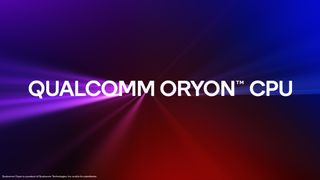Qualcomm’s next-gen PC processors to compete with Apple officially named Snapdragon X Series
Building on the forthcoming Oryon CPU, the Snapdragon X chips will create ‘an inflection point for the PC industry.’

What you need to know
- Qualcomm just announced its new Snapdragon X Series platform for PC.
- Snapdragon X Series is built off the next-gen Oryon CPU, built by ex-Apple engineers.
- More details about Oryon and Snapdragon X Series will be revealed later in October at the Snapdragon Summit.
Just a few weeks before officially unveiling its next-gen PC processors, Qualcomm announced the name of its newest PC platform: Snapdragon X Series.
Snapdragon X Series features Qualcomm’s in-house built Oryon CPU, created by the Nuvia team of ex-Apple engineers that Qualcomm acquired in early 2021 for $1.4 billion. That processor, named last year, is not an Arm Ltd design, which is what its previous Snapdragon 8cx platform was based on.
In late 2021, Qualcomm claimed this new processor is "designed to set the performance benchmark for Windows PCs" and will be an "M-series competitive solution for the PC."
Indeed, a recent report from SemiAccurate claims Oryon CPUs perform "slightly more than the Apple M2 cores," which currently power Apple’s MacBook and MacBook Pro laptop portfolio. Apple, however, is expected to release its M3 series of CPUs either later this year or early 2024.
Nonetheless, a PC processor that can beat Apple’s M2 in power and efficiency would be a massive win for the Windows PC industry and an excellent start for Qualcomm’s efforts in the laptop market.
In addition to the Oryon CPU, the heart of the Snapdragon X Series, Qualcomm also includes its GPU solution and NPU, which “will deliver accelerated on-device user experiences for the new era of generative AI.”
Microsoft's rumored Windows 12 OS refresh, anticipated for fall 2024, focuses significantly on AI and will be a good launch pad for Qualcomm's new PC platform. That OS also drops Arm32 app support in favor of Arm64.
Get the Windows Central Newsletter
All the latest news, reviews, and guides for Windows and Xbox diehards.

Why Snapdragon X Series and when?
As to how Qualcomm decided on the name Snapdragon X, the company explained in its press release:
- The X identifier distinguishes our PC platforms from other Snapdragon product categories.
- The premium design celebrates this monumental leap forward in computing, and the user experiences it will enable.
- A clear, simplified tiering structure helps users navigate our platform capabilities from mainstream to premium.
- All while leveraging the global brand equity of Snapdragon.
We won’t have to wait long to learn about the details of Oryon and Snapdragon X Series chips as the company is hosting its annual Snapdragon Summit from October 24 through the 26th in Maui.
Details about performance, efficiency, and some reference design laptops powered by the next-gen chip will be revealed. We will also likely hear of PC launch partners, possibly from HP, Lenovo, Dell, and others expected to have new Windows laptops featuring Snapdragon X Series. However, consumers won't get onto such PCs until sometime in 2024, when they hit mass production.
Combined with Intel’s latest Meteor Lake announcement, the Windows laptop landscape 2024 will be very interesting, competitive, and a likely challenge to Apple.
Windows Central will be at the Snapdragon Summit on October 24-26 to cover the unveiling of the new processors.

Daniel Rubino is the Editor-in-chief of Windows Central. He is also the head reviewer, podcast co-host, and analyst. He has been covering Microsoft since 2007, when this site was called WMExperts (and later Windows Phone Central). His interests include Windows, laptops, next-gen computing, and watches. He has been reviewing laptops since 2015 and is particularly fond of 2-in-1 convertibles, ARM processors, new form factors, and thin-and-light PCs. Before all this tech stuff, he worked on a Ph.D. in linguistics, watched people sleep (for medical purposes!), and ran the projectors at movie theaters because it was fun.
-
naddy69 None of this will matter until all Windows software is converted to native ARM code . What's the point of super fast and efficient ARM hardware if you are just running Intel code in emulation?Reply
I had a Surface Pro X in the summer of 2020 . At that time, lots of stuff included with Windows was still Intel code . Including notepad, Windows media player, etc . The Edge browser was ARM code and ran very fast, but the system service that was always running that checked for Edge updates was Intel code . How lame is that?
After a couple months I gave up on WOA and sold the X on eBay . The hardware was great - as good as an iPad Pro - but the software was a joke. -
bradavon Reply
Agreed it won't matter until Windows 11 can also do x86 to ARM translation like MacOS.naddy69 said:None of this will matter until all Windows software is converted to native ARM code . What's the point of super fast and efficient ARM hardware if you are just running Intel code in emulation?
I had a Surface Pro X in the summer of 2020 . At that time, lots of stuff included with Windows was still Intel code . Including notepad, Windows media player, etc . The Edge browser was ARM code and ran very fast, but the system service that was always running that checked for Edge updates was Intel code . How lame is that?
After a couple months I gave up on WOA and sold the X on eBay . The hardware was great - as good as an iPad Pro - but the software was a joke.
But disagreed it's a joke. I've only been using a Surface Pro X SQ1 since 2020 and most apps run great or good.
The problems do exist but it was never a fair comparison when tech reviewers always review devices against such a limit selection of apps. Photoshop, Chrome and Slack basically
Microsoft really need to be getting Google onboard though. Chrome for Windows on ARM has been done for years at this point.